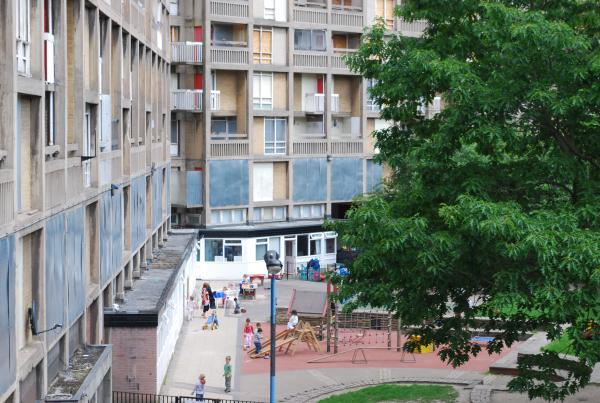
Architect:
Ivor Smith & Jack Lynn, (Britain)
Construction Date:
1961
Location:
Sheffield
Icon of Unpopularity
In the history of the British Modern Movement, a handful of buildings are so widely regarded as beautiful that they have become architectural icons: the De La Warr Pavilion and Highpoint One are good examples.
Conversely, there is more than a handful of buildings that have achieved iconic status for all the wrong reasons: buildings which are so widely loathed that they have come to symbolise what the public at large dislike about Modernist architecture: for years, Trellick Tower held this dubious honour. Not far behind was the Park Hill estate in Sheffield.
Completed in 1961, Park Hill was intended to provide local authority housing for thousands of people. A largely working-class industrial city, whose best days were behind it, the city fathers of Sheffield hoped that Park Hill would signal the rejuvenation of the town and provide quality homes in a deprived area.
Streets in the Sky
The council turned to two young Modernists to realise their vision. Ivor Smith and Jack Lynn were graduates of the Architectural Association and heavily influenced by Alison and Peter Smithson.
Modernists like the Smithsons were beginning to question the decades-old vision of giant towers set in green parkland as a workable model for urban regeneration.
Denys Lasdun had just completed Keeling House in London, an attempt to build a collection of tower blocks designed to preserve the sense of community which existed in narrow, working class streets. Even the master himself, Le Corbusier, had, with his Unité d'Habitation in Marseilles, signalled a new approach to social housing: relatively low-rise blocks, packed with amenities.
Park Hill is one of the most spectacular examples of new approaches to communal living in post-war Britain. Consisting of 995 dwellings, and housing over two thousand people, it occupies an entire hill overlooking Sheffield city centre, and is built on a slope, so increases in height as the hill slopes away. The estate consists of huge snake-like blocks which contain the duplex apartments and the estate's famous 'streets in the sky', (based on the Smithsons' Golden Lane Housing plan of 1952), a bold attempt to preserve the communal benefits of street-life.
The New Urban Cool
Each apartment had a front door which looked out onto a twelve-feet wide access deck ('street'), which ran from one side of the scheme to the other. Bridges carried the street through the entire scheme, allowing milk floats to trundle from door to door.
Jack Lynn was worried that the lobby space in other Modernist estates tended to become a no-man's land, serving neither public needs nor offering privacy to residents, and it was hoped that the 'streets' would solve this problem. He remarked enthusiastically on the different colours of linoleum at each doorstep as proof that residents' individuality was not being smothered by gargantuan surroundings.
But Park Hill's problems quickly became apparent. The streets allowed some of the worst aspects of urban life to remain (muggers found they made convenient getaway routes), whilst failing to preserve the better aspects.
They were never really streets in the real sense. Although the architects had included shops, a school, and a pub in order to create a distinctive community within the estate, the access decks were really just long walkways with none of the vibrancy, diversity, and organic feel of a city street which has grown and changed over decades or even centuries.
In the Unité d'Habitation in Marseilles, Le Corbusier had enclosed his streets within the building: in Sheffield they were left open on one side, and exposed to the less clement Yorkshire climate.
Park Hill was awarded a Grade 2* listing in 1998. Although an important milestone in the development of Modernist housing theory in post-war Britain, the public incredulity which greeted the award spoke volumes about the success of Park Hill and its 'streets in the sky'.
Rate and Review
Rate this article
Review this article
Log into OpenLearn to leave reviews and join in the conversation.
Article reviews